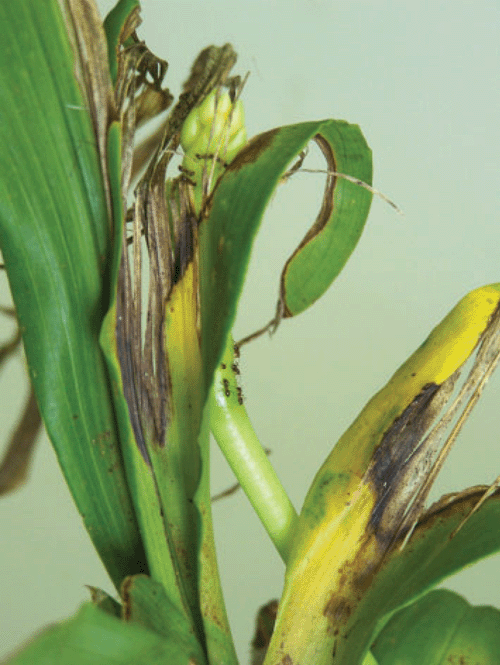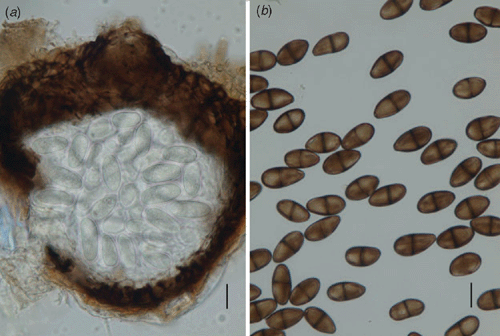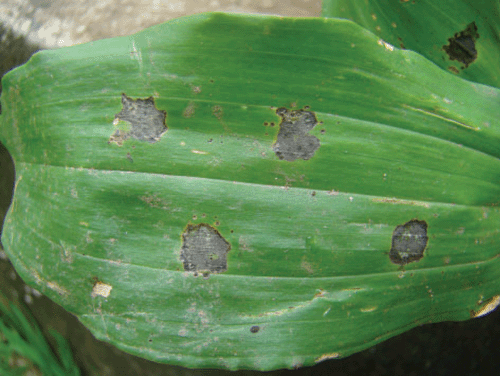First report of Lasiodiplodia theobromae causing leaf blight on the orchid Catasetum fimbriatum in Brazil
U. P. Lopes A , L. Zambolim A and O. L. Pereira A BA Departamento de Fitopatologia, Universidade Federal de Viçosa, 36570-000 Viçosa, M.G., Brazil.
B Corresponding author. Email: oliparini@ufv.br
Australasian Plant Disease Notes 4(1) 64-65 https://doi.org/10.1071/DN09027
Submitted: 30 April 2009 Accepted: 25 May 2009 Published: 10 June 2009
Abstract
A leaf blight caused by Lasiodiplodia theobromae is reported for the first time on the orchid Catasetum fimbriatum.
Catasetum fimbriatum (Morren) Lindley is an epiphytic Brazilian orchid, found in the tropical forests and also cultivated by some orchid growers in Brazil. In June 2006 an exploratory project surveying and describing the phytopathogenic and endophytic fungi associated with the family Orchidaceae in the state of Minas Gerais was initiated (Silva and Pereira 2007, 2008; Silva et al. 2008). Samples of C. fimbriatum with severe leaf blight symptoms were collected from a fragment of rain forest in the city São Miguel do Anta, State of Minas Gerais, Brazil. Spots were initially chlorotic, became necrotic and black with a chlorotic halo, coalescing to cover the entire width of the leaves, and leading to leaf death (Fig. 1).

|
Associated with these symptoms was a fungus that had the following morphology: pycnidia immersed in leaf tissue, solitary, subepidermal, pyriform, black, 160–185 × 185–200 μm, glabrous, with an apical ostiole (Fig. 2a); wall stromatic, composed of several layers of dark brown, thick walled cells; conidia ellipsoidal, one-celled, hyaline when immature, becoming dark brown and striate with age, 22.5–28.5 × 12.5–13.5 μm (Fig. 2b). Material examined: VIC 30781, on leaves of Catasetum fimbriatum, São Miguel do Anta, State of Minas Gerais, Brazil, U.P. Lopes, 05 Feb 2008.

|
The fungus fits the description of Lasiodiplodia theobromae (Pat.) Griffon & Maubl. (Punithalingam 1976), which is a well-known pathogen commonly associated with root, collar and stem rot, dieback and post-harvest diseases, but not reported as the cause of orchid leaf blight in Brazil.
The fungus was isolated in culture, and mycelial plugs containing reproductive structures were taken from a 7-day-old colony growing on potato dextrose agar (PDA) and placed on wounded leaves, both young and mature, of C. fimbriatum. The inoculated plants were maintained in a moist chamber for 2 days and then in a greenhouse at 25°C. Necrotic symptoms (Fig. 3), similar to those described were detected 2 days after the inoculation on young and mature leaves. The control leaves, on which only PDA plugs were placed, remained healthy.

|
Only two fungi are known to cause disease on the orchid C. fimbriatum: Sphenospora kevorkianii Linder (Pereira and Barreto 2004) and Uredo carnosa Spegazzini (Hennen et al. 2005). However, Hennen et al. (2005) reported that U. carnosa probably is an anamorph of S. kevorkianii.
This is the first report of L. theobromae causing leaf blight on the orchid C. fimbriatum. Despite the fact that this disease has been observed only on plants growing in their natural habitats, they may become a serious problem for some Brazilian orchid growers, due to the severity of the disease and the lack of registered chemical products for this pathogen on orchids.
Acknowledgements
We are grateful to Fundação de Amparo à Pesquisa do Estado de Minas Gerais-FAPEMIG for providing financial support (project 279/07) and O. L. Pereira acknowledges the Conselho Nacional de Desenvolvimento Científico e Tecnológico-CNPq research fellowship of this ongoing program of surveying and describing the phytopathogenic and the endophytic mycodiversity associated with the family Orchidaceae in the state of Minas Gerais.
Pereira OL, Barreto RW
(2004) First report of Sphenospora kevorkianii (Raveneliaceae) on the orchid Catasetum fimbriatum in Brazil. Plant Pathology 53, 256.
| Crossref | GoogleScholarGoogle Scholar |

Silva M, Pereira OL
(2007) First report of Guignardia endophyllicola leaf blight on Cymbidium (Orchidaceae) in Brazil. Australasian Plant Disease Notes 2, 31–32.
| Crossref | GoogleScholarGoogle Scholar |

Silva M, Pereira OL
(2008) Black mildew disease of the neotropical orchid Epidendrum secundum caused by Lembosia epidendri sp. nov. from Minas Gerais, Brazil. Mycotaxon 104, 385–390.

Silva M,
Pereira OL,
Braga IF, Lelis SM
(2008) Leaf and pseudobulb diseases on Bifrenaria harrisoniae (Orchidaceae) caused by Phyllosticta capitalensis in Brazil. Australasian Plant Disease Notes 3, 53–56.



